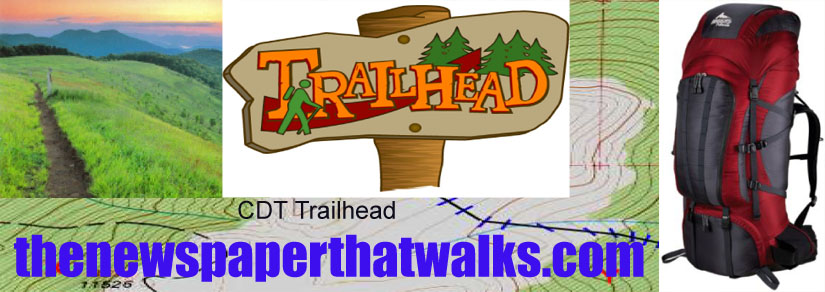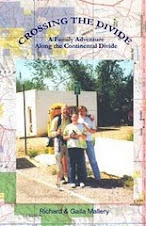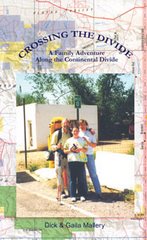 The Amazon Outdoor Store
The Amazon Outdoor StoreFulfilling a lifelong dream Mallerys publish book on trek along the Continental Divide
By MARTA HEPLER DRAHOS-Traverse City Record Eagle
What does it take to walk 3,800 miles through some of North America's most rugged — and beautiful — country.
Click he
 re to visit mallerybooks.com
re to visit mallerybooks.comWanderlust, tenacity and lots of family support, said Dick Mallery, co-author of the book "Crossing the Divide: A Family Adventure along the Continental Divide” (MalleryBooks, $18.95).Mallery, publisher and founder of the bird-feeding and nature newspaper The Dick E. Bird News, fulfilled a 30-year dream in 2003 by completing the Continental Divide Trail from New Mexico to Jasper, Alberta. Instead of leaving his family behind, he shared the adventure with wife Gaila and daughter Maggie, who followed in the front country in the family's 27-foot motor home
 towing a Saturn.
towing a Saturn.Dick Mallery heads back on the Continental Divide Trail after resupplying in Twin Lakes, Colo.,in 1999.
The family began their adventure in 1999, the year Mallery turned 50. That year, he walked 3,200 miles along the Continental Divide from New Mexico to the Canadian border — a trip that would take him through five states in five months. Gaila and Maggie, then 12, were his support team, driving the motor home to campgrounds paralleling his route and meeting him on his weekly exits from the trail for more supplies and a little R&R.A few years later, the family returned to where they left off for the next leg of the journey, a 30-day 600-mile hike of the Canadian Continental Divide from Waterton to Jaspar, Alberta.The Continental Divide Trail follows an imaginary line running along the peaks of the Rocky Mountains that divides the continent's principal drainage eastward or westward. Mallery, now 58, said the rugged trip was not designed to recapture his youth but rather to challenge himself, push his personal limits and achieve that lifelong dream."I knew that was on my list of things to do before I died,” he said, adding that his passion for trekking and backpacking was fueled by childhood camping trips out West in his family's 1957 Airstream. "I kind of wanted to do it while Maggie was still home so we could make a family adventure of it.”Hiking alone with a 26-pound pack, he traveled 25 to 30 miles a day over mountains, across deserts and through streams and valleys, contending with everything from weather extremes to blisters and leg cramps. But he said one of the biggest challenges was water — locating enough to drink on the first trip and finding ways to bridge it on the second."There were a couple hairy times in the Canadian Rockies where I just couldn't cross,” he said. "The river was just 30 feet across, but so powerful it would knock you over.”Another problem was navigation, he said. Although the trail is considered the "king of trails,” it was only 60 percent complete at the time — and finding maps for it wasn't easy."I was lost a lot, especially in New Mexico,” despite such aids as then-unsophisticated versions of the GPS, the satellite communicator and the cell phone, he said. "I'd just go north and stay on the Divide as much as I could.”For their part, Gaila and Maggie restocked Mallery's supplies — strawberry milkshakes and pizza for off the trail, dehydrated beans and Ritz Bits for on it — and scouted campgrounds with hot showers, his first request after emerging from the trail. They also kept the business going with the help of a laptop computer, even passing out sample issues of the newspaper everywhere from bakeries and libraries to campgrounds and parks. (To prepare for the trip, the family scaled back the publication to a bi-monthly, printed three issues in advance and asked Mallery's father to deliver them to the post office one issue at a time.)The trip was a bonding experience for Gaila, whose parents from Arizona accompanied her and Maggie for much of the way."We became so close,” she said. "It was something that I'll never forget. I think families that travel together, there's just that bond there. And it's really good for children. We have this tradition: We play (the card game) Skip-Bo and have hot chocolate at night. We don't do that at home. I didn't want to come back. It was like, 'I don't want this to end.'"As far as exciting and fun adventures, I think it was going into these little towns that we never would have found otherwise and meeting the people.” Special among them were store owners who extended credit when they didn't take credit cards and librarians who let Maggie check out library books and drop them off at the next community library, she said.The couple recount their adventure from alternating perspectives in the book, which is available online at Amazon.com and at mallerybooks.com. Part of their story is the strangers they met along the way, from hikers to the occasional odd character like Bob Sundown, who traveled from New Mexico to Arizona every spring with his chickens and dog in a mule-drawn covered wagon, and James Cotton, a writer penning the encyclopedic volume of the word "free.”Mallery said he's glad he got the chance to hike on the Divide while there is still some wilderness left. His next goal is a 1,000-mile trek from Jasper to the Yukon, through even more remote and wild areas."I just love doing long-distance hikes. I'm after the solitude,” he said. "I like to get up in the mountains. To me it's magical, to me it's rare.”Meanwhile, he said he hopes the book encourages others to follow their own adventures."I guess the impact it had on me is just that life is short and if you want to do something, you should do it now,” he said.
















